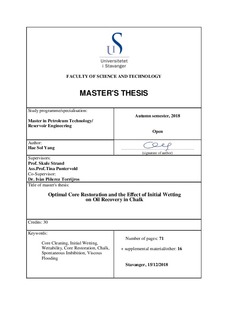| dc.description.abstract | The initial wetting condition of the reservoir rock is fundamental in the advanced oil recovery methods by waterflooding, in particular, in Smart Water EOR. The wettability alteration of the rock surface is induced by several parameters include the ionic composition of the injected brine, the polar components of crude oil, the mineralogy of the rock surface, and the temperature. Experimental studies have revealed that the surface active-components in crude oil, such as carboxylic acids, is the main influence on initial wettability. Restoring the initial wetting of the core to representative condition as reservoir is known to be challenging process because the wettability of the rock may have altered during and after the core sampling. Optimal core restoration procedure that reproduces reservoir wettability is essential when core experiments are performed in the laboratory.
This work is related to the effect of initial wetting on oil recovery, core restoration and core cleaning. The oil recovery from imbibition tests were compared to evaluate the correlation between initial wetting and oil recovery. Stevns Klint outcrops chalk material has been used in this experiment, with initial water saturation of 10%. The restored cores were flooded with crude oil (AN=0.5mg KOH/g, BN=0.23mg KOH/g) and spontaneous and forces imbibition test and Chromatographic wettability test were performed on the core at 50 ºC to analyze the initial wettability. In previous experiment, the core was flooded with 2.5PV of crude oil after mild cleaning and the restored reservoir cores behaved less water-wet. 1PV of crude oil was injected to minimize the effect of wettability alteration by crude oil, in this study.
It is confirmed from the imbibition tests that the oil recovery increases as the wetting of the core behaves more water-wet. The effect of mild core cleaning on the wettability of restored core have been investigated. The experiment shows that initial wetting of the chalk core can be reproducible with mild core cleaning when the reduced amount of crude oil is introduced to the core after restoration. The result in spontaneous imbibition on second restoration cores gave 1.4% to 2.1% change in oil recovery. | nb_NO |
